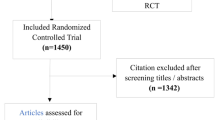Abstract
Objective Pain management in children has improved substantially over the last few years but continues to vary widely across institutions. Our objective was to describe the evaluation and treatment of pain in paediatric patients in two hospitals (Robert Debré in Paris, France, and Sainte-Justine, Montréal, Canada) and to compare conformity with quality criteria. Method Retrospective medical chart of a total of 200 patients with uncomplicated appendectomy, spinal fusion, ureteroneocystostomy, or laparoscopic cholecystectomy were analysed, with special attention to nurses’ entries, prescriptions, and medication administration sheets. Main outcome measure Patient characteristics and variables pertaining to pain evaluation (tool and result) and treatment (date, prescription and administration details) were collected. Quality criteria for evaluating conformity with guidelines were taken from the literature. Any change in medication, dosage, or dosing interval was taken as a new prescription. Results About 929 prescriptions and 2,388 numerical pain scores were recorded for 200 patients. Pain was recorded at 70.8% of vital-sign evaluations at the Robert-Debré Hospital compared to 30.9% at the Sainte-Justine hospital (P < 0.0001). A validated age-appropriate pain evaluation tool was used in 97.4 and 94.1% of evaluations in these two hospitals, respectively (P < 0.0001). Analgesic dosage was appropriate in 92.5% of prescriptions at Robert-Debré and 86.0% of those at Sainte-Justine (P = 0.002). Conclusion This study documents differences in post-operative pain management between two paediatric hospitals. We found differences between the two hospitals regarding the frequency of pain evaluation, the use of validated tools for evaluating pain, and analgesic dosages. Continued efforts to educate prescribing physicians and other healthcare providers are needed to improve pain management in children.
Similar content being viewed by others
References
International Association for the Study of Pain Pain terms: a list with definitions and notes on usage. Recommended by the IASP Subcommittee on Taxonomy. Pain 1979;6(3):249.
Schechter NL. The undertreatment of pain in children: an overview. Pediatr Clin North Am 1989;36(4):781–94.
Schechter NL, Allen DA, Hanson K. Status of pediatric pain control: a comparison of hospital analgesic usage in children and adults. Pediatrics 1986;77(1):11–5.
American Pain Society, American Academy of Pediatrics. The assessment and management of acute pain in infants, children, and adolescents. Pediatrics 2001;108(3):793–7.
Alex MR, Ritchie JA. School-aged children’s interpretation of their experience with acute surgical pain. J Pediatr Nurs 1992;7(3):171–80.
Beyer JE, DeGood DE, Ashley LC, Russell GA. Patterns of postoperative analgesic use with adults and children following cardiac surgery. Pain 1983;17(1):71–81.
Cox TH. An evaluation of postoperative pain management in pediatric patients at a university teaching hospital. Hosp Pharm 1995;30(11):980–92, 95–6.
Banos JE, Barajas C, Martin ML, Hansen E, Cos MA, Bosch F, et al. A survey of postoperative pain treatment in children of 3–14 years. Eur J Pain 1999;3(3):275–82.
Peters J, Koot H, Grunau R, de Boer J, van Druenen M, Tibboel D, et al. Neonatal facial coding system for assessing postoperative pain in infants: item reduction is valid and feasible. Clin J Pain 2003;19:353–63.
Bloch J, Spira R, Gloaguen E, Goldman S, Pawlotsky F, Sznajder M, et al. Enquête nationale sur la prise en charge de la douleur de l’enfant dans les établissements de court séjour [National survey on pediatric pain management in short-term care centers]. 1998 [cited 15 May 2007]; Available from: http://www.pediadol.org/enquete-nationale-sur-la-prise-en-charge-de-la-douleur-de-lenfant-dans-les-etablissements-de-court-sejour.html
Prot-Labarthe S, Bussieres J, Brion F, Bourdon O. Comparison of hospital pharmacy practice in France and Canada: can different practice perspectives complement each other? Pharm World Sci 2007;29(5):526–33.
JCAHO. Pain: current understanding of assessment, management, and treatments. 2001 [cited 15 April 2004]; Available from: http://www.jcaho.org/news+room/health+care+issues/pain+mono_npc.pdf
Registered Nurses Association of Ontario. Assessment and management of pain. 2002 [cited 15 May 2007]; Available from: http://www.rnao.org/bestpractices/index.asp
Geriatrics and Extended Care Strategic Healthcare Group Veterans Health Administration. Pain as the 5th vital sigh toolkit. 2000 [cited 6 May 2004]; Available from: http://www.vachronicpain.org/Downloads/pain5thvitalsignv2.PDF
Annequin D, Tourniaire B, Gatbois E, Lombart B, Martret P. L’essentiel de l’évaluation de la douleur et de la prescription antalgique en pédiatrie. [Pain evaluation and analgesic drugs for children]. 2006 [cited 3 June 2005]; Available from: http://pediadol.canal55.com/article.php3?id_article=180
Wood C, Monidier P. Le diagnostic de la douleur chez l’enfant [Diagnosis of pain in children]. Arch Pediatr 2004;11:1–4.
Groupement d’Intérêt Economique – Système d’Information sur les Produits de Santé. Theriaque. [cited 3 June 2005]; Available from: http://www.theriaque.org
World Health Organization. Cancer pain relief, 2nd edn. 1996 [cited 25 Nov 2005]; Available from: http://www.whocancerpain.wisc.edu/eng/15_3/guidelines.html
Mather L, Mackie J. The incidence of postoperative pain in children. Pain 1983;15(3):271–82.
Logan DE, Rose JB. Gender differences in post-operative pain and patient controlled analgesia use among adolescent surgical patients. Pain 2004;109(3):481–7.
Acknowledgements
Pascale Bouday, Service du programme de médicalisation des systèmes d’information, RD for providing us with access to the hospital databases; Pascal Bessonneau, for statistic assistance; Sylvie Charrette, RN, Postoperative Analgesia Department, SJ, for validating the study design and sharing her experience in the field; SJ and RD Surgery Department.
Funding Société Française de Pharmacie Clinique and Roche Inc. awarded a grant to Olivier Bourdon in 2004 for this project.
Conflict of interests This project was supported by a grant from the Société Francaise de Pharmacie Clinique and Roche Inc. This has, to our knowledge, not influenced the study, its results, or this article.
Author information
Authors and Affiliations
Corresponding author
Rights and permissions
About this article
Cite this article
Prot-Labarthe, S., Pelletier, É., Winterfeld, U. et al. Comparison of pain management in paediatric surgical patients in two hospitals in France and Canada. Pharm World Sci 30, 251–257 (2008). https://doi.org/10.1007/s11096-007-9169-0
Received:
Accepted:
Published:
Issue Date:
DOI: https://doi.org/10.1007/s11096-007-9169-0




